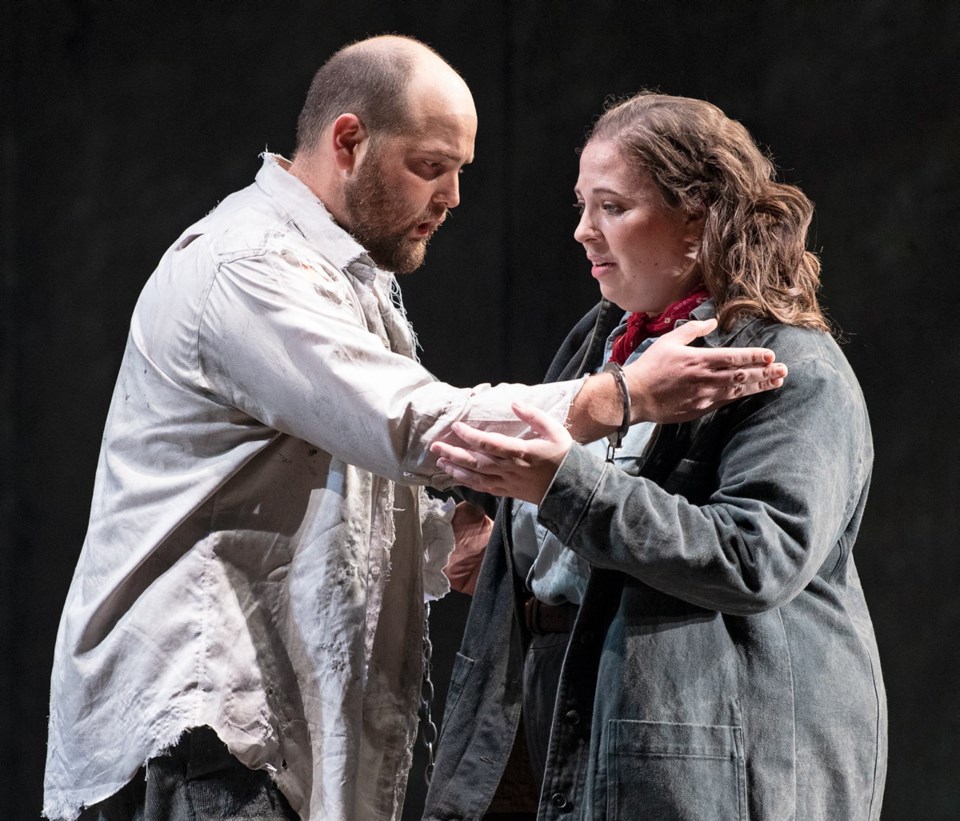What: Pacific Opera Victoria: Beethoven’s Fidelio
When/where: Oct. 13 and 19, 8 p.m.; Oct. 17, 7 p.m.; Oct. 21, 2:30 p.m.; Royal Theatre; pre-performance lectures one hour before curtain
Tickets: $27-$144, student rush $15. Call 250-386-6121 or 250-385-0222; online at rmts.bc.ca; in person at the Royal and McPherson Box Offices and POV (925 Balmoral Rd.)
Pacific Opera Victoria has mounted Beethoven’s Fidelio only once before, in 1988, with a production that was momentous in several respects (it was shown on television by PBS). On Thursday, POV opened a new production of Fidelio, one that is visually arresting, emotionally intense and musically elevated.
The opera centres on Leonore, who disguises herself as a boy named Fidelio and becomes an assistant to a jailer, Rocco, to rescue her husband, Florestan, a political prisoner who is threatened with execution by the prison governor, Don Pizarro. Running alongside this story is a homelier subplot involving Rocco’s daughter, Marzelline, and another of his assistants, Jaquino.
With its critique of tyranny and injustice and its profound human concerns (conjugal love and fidelity, freedom, brotherhood, courage), Fidelio certainly reflected Beethoven’s Enlightenment beliefs. The libretto has weaknesses, it’s true, and Beethoven was not by nature a man of the theatre, but the score, a quintessential document of his middle-period style, is full of magnificent, dramatically charged music.
Alas, Fidelio was a notorious problem-child for Beethoven. He wrote three versions of it, which were mounted in Vienna in 1805, 1806 and 1814. (For good measure, he wrote four overtures.) The work had some success, but Beethoven, who said he deserved a “martyr’s crown” for all the trouble it had given him, would never again try his hand at opera.
Though it is in German, Fidelio was based on a French libretto and it is a late specimen of 18th-century French-style “rescue opera.” The score is much indebted to French opera and orchestral music, and as in French opéra comique, there is spoken dialogue instead of recitative. In POV’s production, both singing and dialogue are in German, with surtitles.
Director Wim Trompert, working with set and costume designer Nancy Bryant, offers a convincing and appropriate modern-dress concept and staging that is thoughtful, but unfussy. Bryant’s striking-looking triangular set proves versatile, and opens up several times to splendid effect — for instance, for the moving chorus of prisoners in the Act 1 finale.
To serve his concept, Trompert has tweaked the libretto, placing Leonore among a group of resistance fighters (he establishes this through mime during the overture). And his concept is underscored by a kaleidoscope of still and moving images (designed by Monica Hernandez) that are projected onto a scrim and along one side of the “triangle.” They provide running commentary on the action, though they are sometimes distracting and occasionally head-scratching.
The two sopranos are both commanding technically, but have very different vocal personalities appropriate to their characters: Miriam Khalil as Marzelline is the more ingratiating, while Aviva Fortunata as Leonore is the more heroic, emerging as a real powerhouse in her Act 1 aria Come, Hope.
Fortunata is well matched with tenor Brent Reilly Turner, who renders the imprisoned Florestan’s Act 2 aria (God! What darkness here!) with impressive passion and power across a range of feelings — despair, resignation, fortitude and longing. When husband and wife finally reunite late in Act 2 (O nameless joy!), we hear a veritable explosion of ardent lyricism.
All of the vocal ensembles, in fact, make a big impact, and there is strong work in the smaller roles, especially in two bass parts: Valerian Ruminski, as Rocco, affectingly conveys a basically decent man weighed down by ethical compromises, and Peter McGillivray, as Pizarro, offers a juicy portrait of a man all but deranged by his thirst for power and vengeance. (McGillivray was fondly booed during his curtain call on Thursday — sure evidence of effective villainy.)
The Victoria Symphony, conducted by POV’s artistic director, Timothy Vernon, plays with extraordinary colour and fervour, and underscores the music’s heroism — for instance, through prominence of woodwind and brass sonorities and a string tone that is solid rather than sensuous. Vernon injects much energy and momentum into the performance (the Act 2 climaxes are thrilling), but also takes time generously to allow for a wealth of nuance.



